Revell 1/96 Apollo-Soyuz US-Soviet Space Link-Up |
| Introduction Many years ago, the Apollo-Soyuz Test Project (ASTP) was thought of by NASA and the Soviet space agency. This project was to test several new ideas - could the two 'enemies' rendezvous in space, could their dissimilar systems dock together, could the crews work together? These weren't ideas that could be discounted - space is a dangerous environment, and if each agency knew that they could, if need be, rely on the other to help rescue stranded astronauts/cosmonauts, all concerned could rest a little easier. And so the ASTP was born, using tried and tested technology on both sides ' the Apollo modules by the US and the Soyuz capsule by the Soviets. I've always been fascinated by this project - not only because it saw a thawing in the often-stormy relationship between the two super-powers, but also from the technological point of view. The craft were launched from areas far apart in distance and in latitude, and they had to achieve a rendezvous; once there, they had to mate the two craft together; they had experiments to do jointly, and needed to be able to understand each other; there were trials of emergency aid and rescue. It was a demanding mission, for both sides, and it was an area neglected by model companies for many years. Recently, Revell have dug into their back-catalogue and have re-issued a number of space-related kits, and I was delighted to see in a specialist model shop the ASTP kit. This was originally released back in the early 1970s, but I never found it. I snapped this up as soon as I saw it because about 12 years ago I found the limited release envelope, stamps from both countries and a specially-minted coin on sale in a local market - when I went back an hour later it had already been sold. I wasn't going to let THIS one escape! So, what do you get for your money? The box art is one of those 1970s impressions of how it was supposed to look, and (truth be told) it's reasonably accurate to the two craft. The Apollo modules could do with some more detail, but they are in the background (and there are MANY references to them), but the Soyuz is nicely detailed, and has accurate colours. The wording on the box is in both English and Russian - as are the instructions; looks like this kit was marketed on both sides of the Iron Curtain. Moving inside, as just mentioned, the instructions are in both languages. They are on one long sheet of paper, folded to make up six sides of A4. 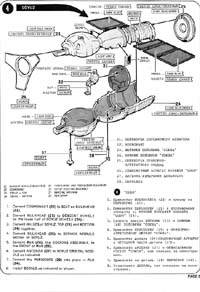 The front page gives basic information on what the aims were, and has a diagram of the various stages of the Project together with time-scales (eg. The Apollo launch was 7.5 hours after the Soyuz, docked operations were scheduled for two days, etc). The front page gives basic information on what the aims were, and has a diagram of the various stages of the Project together with time-scales (eg. The Apollo launch was 7.5 hours after the Soyuz, docked operations were scheduled for two days, etc).
Continuing on, page two has a small section on tools required and hints, but most of the page is on the assembly and painting of the Apollo Command Module (CM). Included in the CM are instrument panels and an astronaut in the reclined seats (9 parts in all); decals are also included here. Page three concerns itself with the Apollo Service Module (SM), again including painting and decal instructions (there are 11 parts here). Page four moves to the Docking Module (DM). As this only has four parts and two colours, this should be simplicity itself. It is worth noting here that the DM was carried by the Apollo craft - in the docking, the Soyuz just stayed still while the Apollo did all the catching up and fine adjustments required. Page five moves across to the Soyuz, and again includes a cosmonaut and instrumentation (in total, eight parts), as well as painting and decal information. The last page shows the final assembly of the four assemblies, and the mounting of the kit onto the base. This is an ingenious method – the stand attaches itself to the underside of the Apollo SM, with the model projecting over the base in a realistic position. 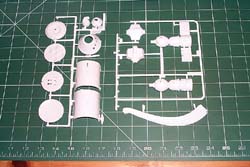 So, what are the parts actually like? Well, anyone expecting wonderful crisp sprues with fantastic detailing - basically, what we expect in today's kits - will be So, what are the parts actually like? Well, anyone expecting wonderful crisp sprues with fantastic detailing - basically, what we expect in today's kits - will be 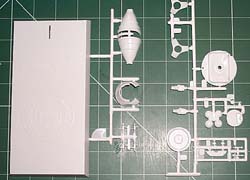 disappointed; the moulds are getting on over 25 years old! But this isn't to say they aren't in bad condition. The base has the logo of the ASTP moulded into it nicely; the parts with detailing in them, for example panel lines and rivets, are well-done for when they were sculpted. All parts are easily identified and while it must be said that the majority have flashing around them, for the most part it is minimal - all the worst sections of flashing are against the body of the sprues. Minor clean-up will be required on all parts, but no more than that. disappointed; the moulds are getting on over 25 years old! But this isn't to say they aren't in bad condition. The base has the logo of the ASTP moulded into it nicely; the parts with detailing in them, for example panel lines and rivets, are well-done for when they were sculpted. All parts are easily identified and while it must be said that the majority have flashing around them, for the most part it is minimal - all the worst sections of flashing are against the body of the sprues. Minor clean-up will be required on all parts, but no more than that. 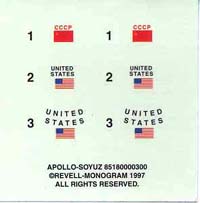 Looking at the decal sheet, it's pretty basic. There are two CCCP flags, two similar United States flags and two curved United States flags, and that's it. While they may require a little bit of trimming, they are acceptable. The hammer and sickle are just visible to the naked eye on the Soviet decals; it requires a good magnifier to see the stars on the US flag, but they ARE there. Looking at the decal sheet, it's pretty basic. There are two CCCP flags, two similar United States flags and two curved United States flags, and that's it. While they may require a little bit of trimming, they are acceptable. The hammer and sickle are just visible to the naked eye on the Soviet decals; it requires a good magnifier to see the stars on the US flag, but they ARE there. Conclusion So, overall am I happy with this? I'd say yes. It's in one of the regular scales for space models, although I would have preferred 1/72. The level of detailing is acceptable, as is the quality of the moulding. It's of an uncommon, and historically interesting, subject. I like it. One final word: Revell are dropping a whole range of kits, so if this is a subject you like, get it now, before it's too late! | 


 



  
    |
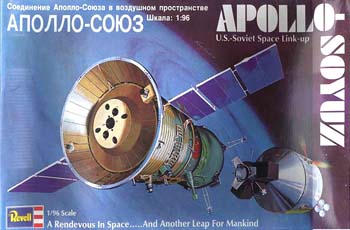
 The front page gives basic information on what the aims were, and has a diagram of the various stages of the Project together with time-scales (eg. The Apollo launch was 7.5 hours after the Soyuz, docked operations were scheduled for two days, etc).
The front page gives basic information on what the aims were, and has a diagram of the various stages of the Project together with time-scales (eg. The Apollo launch was 7.5 hours after the Soyuz, docked operations were scheduled for two days, etc). So, what are the parts actually like? Well, anyone expecting wonderful crisp sprues with fantastic detailing - basically, what we expect in today's kits - will be
So, what are the parts actually like? Well, anyone expecting wonderful crisp sprues with fantastic detailing - basically, what we expect in today's kits - will be  disappointed; the moulds are getting on over 25 years old! But this isn't to say they aren't in bad condition. The base has the logo of the ASTP moulded into it nicely; the parts with detailing in them, for example panel lines and rivets, are well-done for when they were sculpted. All parts are easily identified and while it must be said that the majority have flashing around them, for the most part it is minimal - all the worst sections of flashing are against the body of the sprues. Minor clean-up will be required on all parts, but no more than that.
disappointed; the moulds are getting on over 25 years old! But this isn't to say they aren't in bad condition. The base has the logo of the ASTP moulded into it nicely; the parts with detailing in them, for example panel lines and rivets, are well-done for when they were sculpted. All parts are easily identified and while it must be said that the majority have flashing around them, for the most part it is minimal - all the worst sections of flashing are against the body of the sprues. Minor clean-up will be required on all parts, but no more than that. Looking at the decal sheet, it's pretty basic. There are two CCCP flags, two similar United States flags and two curved United States flags, and that's it. While they may require a little bit of trimming, they are acceptable. The hammer and sickle are just visible to the naked eye on the Soviet decals; it requires a good magnifier to see the stars on the US flag, but they ARE there.
Looking at the decal sheet, it's pretty basic. There are two CCCP flags, two similar United States flags and two curved United States flags, and that's it. While they may require a little bit of trimming, they are acceptable. The hammer and sickle are just visible to the naked eye on the Soviet decals; it requires a good magnifier to see the stars on the US flag, but they ARE there.






